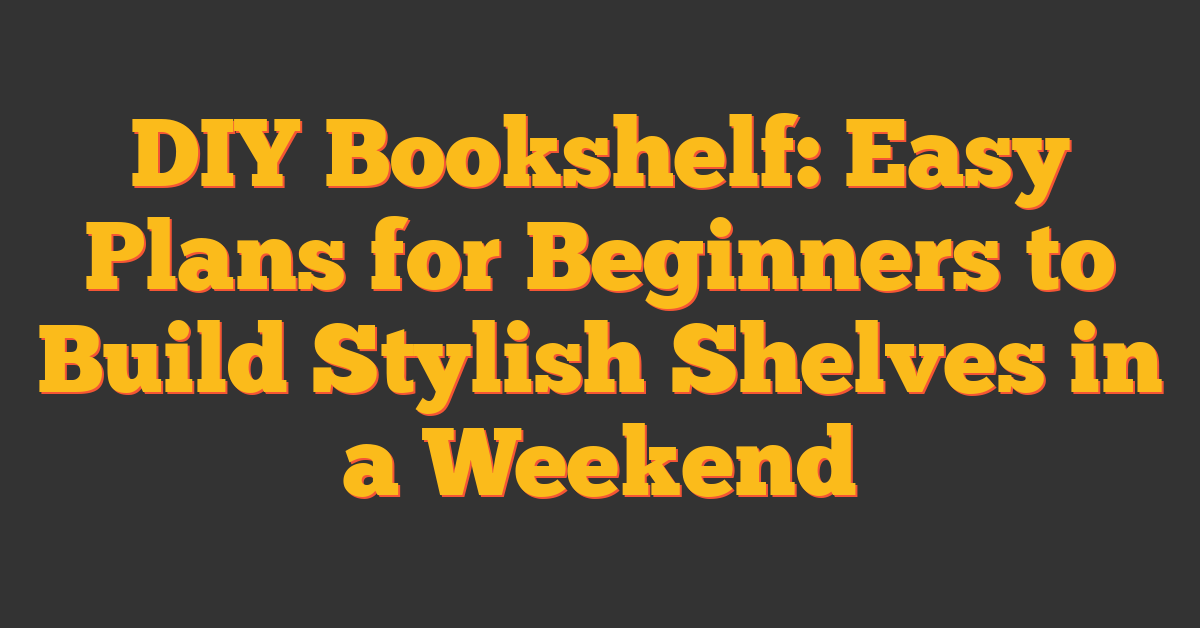Are you looking to add some greenery to your outdoor space? Building a garden planter box is a fantastic way to create a personalized garden area. Whether you’re a seasoned gardener or just starting out, crafting your own planter box gives you the flexibility to design something that fits your space and style.
With just a few materials and some basic tools, you can construct a planter box that not only enhances your garden but also provides a thriving environment for your favorite plants. Imagine having a spot where you can grow vibrant flowers, fresh herbs, or even your own vegetables right at home.
Let’s dive into the steps to help you get started on your garden planter box project.
Benefits Of A Garden Planter Box
- Customization: You can design your planter box to match your garden’s dimensions and your personal style, ensuring it fits perfectly into your space.
- Improved Plant Health: Controlling the soil composition and drainage in your planter box creates an optimal environment for your plants to thrive.
- Space Efficiency: Planter boxes help you make the most of limited areas like patios or balconies, allowing you to grow a variety of plants without clutter.
- Mobility: Easily move your planter boxes to different locations to follow the sunlight or rearrange your garden layout as needed.
- Aesthetic Appeal: Choose the type of wood and finish to complement your outdoor decor, enhancing the overall look of your garden.
- Easy Maintenance: Planter boxes simplify gardening tasks such as watering, weeding, and harvesting, making your gardening experience more enjoyable.
Planning Your Planter Box
Begin by carefully planning your planter box to ensure it fits your garden space and meets your gardening needs.
Choosing The Right Location
Select a spot that receives at least six hours of sunlight each day, crucial for most plants. Ensure the area has easy access to water and is level to provide stability for your planter box. Proximity to your gardening tools and seating areas enhances convenience and efficiency.
Selecting Materials
Choose durable, rot-resistant wood like cedar or redwood for longevity. Opt for untreated lumber to prevent chemicals from leaching into the soil. Gather necessary materials, including boards, screws, and a waterproof sealant. Measure your space accurately to purchase the right quantities, ensuring a perfect fit for your garden.
Tools And Supplies Needed
To build your garden planter box, gather the following tools and materials:
Tools
- Saw: Use a circular saw or handsaw to cut lumber to the desired dimensions.
- Drill: Essential for pre-drilling holes and driving screws securely.
- Measuring Tape: Ensures accurate measurements for all wood pieces.
- Level: Guarantees your planter box sits evenly.
- Screwdriver: Helpful for assembling components and tightening screws.
- Sandpaper: Smooths rough edges and surfaces for a polished finish.
Supplies
- Rot-resistant Wood: Select cedar or redwood boards for durability against the elements.
- Wood Screws: Opt for 2.5-inch, weather-resistant screws to hold the structure together.
- Wood Glue: Provides extra strength to wood joints.
- Drill Bits: Choose sizes appropriate for screws and any hardware you plan to use.
- Landscape Fabric: Prevents soil from escaping and inhibits weed growth.
- Potting Soil: Use high-quality soil tailored to the types of plants you intend to grow.
- Corner Brackets: Adds stability to the corners of your planter box.
- Handles: Optional for easier transport and mobility of the planter box.
Having these tools and supplies ready will streamline the construction process, allowing you to create a sturdy and attractive garden planter box efficiently.
Step-By-Step Construction
Begin constructing your garden planter box by accurately measuring and cutting the wood. Proceed to assemble the box ensuring stability and durability.
Measuring And Cutting Wood
Accurate measurements ensure a perfect fit for your planter box. Use a measuring tape to mark dimensions:
- Sides: Measure length and height based on available space. For a standard box, use 24 inches long and 12 inches high.
- Bottom: Calculate area by multiplying length by width, e.g., 24″ x 12″.
- Corners: Ensure all angles are 90 degrees for stability.
Cut the wood using a saw for precise edges. Sand all cut edges to remove splinters and ensure smooth assembly.
Assembling The Box
Secure the sides together to form the planter box frame. Follow these steps:
- Attach Sides: Use wood glue and screws to connect the side panels at each corner.
- Install Bottom: Place the bottom panel inside the frame, aligning edges precisely.
- Reinforce Corners: Add corner brackets for extra strength, driving screws through pre-drilled holes.
- Apply Landscape Fabric: Line the interior to prevent soil from escaping while allowing drainage.
- Finish Edges: Sand any rough areas and apply a weather-resistant sealant to protect the wood.
By following these steps, your garden planter box will be sturdy, functional, and ready to enhance your outdoor space.
Finishing Touches
Finalize your planter box by ensuring all surfaces are smooth. Sand each side with fine-grit sandpaper to eliminate splinters and create a polished look. Apply a weather-resistant sealant or paint to protect the wood from moisture and UV damage. Choose colors that complement your outdoor space for a cohesive appearance.
Install drainage holes if not already included. Use a drill to create evenly spaced holes at the bottom to prevent waterlogging. Attach decorative hardware, such as handles or brackets, for added functionality and style. These elements enhance both the practicality and aesthetic of your planter box.
Line the interior with landscape fabric to retain soil while allowing excess water to escape. This step promotes healthy plant growth by maintaining optimal soil conditions. Arrange your plants thoughtfully, considering height and color to create a vibrant and organized display.
Perform a final inspection to ensure all components are securely fastened and the structure is stable. Make any necessary adjustments to guarantee your planter box is ready for planting. These finishing touches not only protect your investment but also elevate the overall look of your garden.
Maintenance Tips
Maintaining your garden planter box ensures longevity and healthy plants. Follow these tips to keep your planter in top condition:
- Water Consistently
Ensure plants receive adequate moisture by watering them regularly, especially during dry periods.
- Inspect for Pests
Monitor plants for signs of insects or diseases, and take action promptly to prevent infestations.
- Prune Plants
Trim overgrown foliage to promote healthy growth and improve airflow within the planter.
- Clean the Planter
Remove debris and dead plants to maintain a tidy appearance and reduce the risk of mold.
- Check Drainage
Verify that drainage holes are clear, allowing excess water to escape and preventing root rot.
- Treat the Wood Annually
Apply a weather-resistant sealant each year to protect the wood from moisture and sun damage.
- Adjust Plant Placement
Rearrange plants as needed to optimize sunlight exposure and accommodate growth.
- Seasonal Inspections
Examine the planter box for any signs of wear or damage, making repairs promptly to extend its lifespan.
By following these maintenance tips, you ensure your garden planter box remains a functional and attractive addition to your outdoor space.
Conclusion
Building your own garden planter box opens up a world of possibilities for your outdoor space. It’s a rewarding project that allows you to express your style while creating a haven for your favorite plants.
With just a few basic materials and some time, you can craft a planter that fits perfectly in your garden, balcony, or patio. Enjoy the flexibility of moving your plants to catch the best sunlight or rearranging your setup as your garden evolves.
Taking care of your planter box is simple, making gardening more enjoyable and less of a chore. You’ll love watching your plants thrive in the environment you’ve created.
So grab your tools and get started on your planter box project. Your garden will thank you for it!
Frequently Asked Questions
What is a garden planter box?
A garden planter box is a container designed to hold plants, flowers, herbs, or vegetables. It enhances outdoor spaces by adding greenery and can be customized to fit individual styles and garden dimensions. Suitable for both beginners and experienced gardeners, planter boxes allow controlled soil composition and drainage, improving plant health while saving space in areas like patios or balconies.
Who can build a garden planter box?
Anyone with basic DIY skills can build a garden planter box. Whether you’re an experienced gardener or a beginner, the project is straightforward and requires only simple materials and tools. Customizing the design to match your personal style and garden space makes it accessible and enjoyable for a wide range of skill levels.
What materials are needed to build a planter box?
To build a garden planter box, you’ll need durable, rot-resistant wood like cedar or redwood, untreated lumber to prevent chemical leaching, weather-resistant wood screws, wood glue, and landscape fabric. Essential tools include a saw, drill, measuring tape, level, screwdriver, and sandpaper. These materials ensure your planter box is sturdy and long-lasting.
Why choose wood for a planter box?
Wood is a popular choice for planter boxes because it is durable, aesthetic, and easy to work with. Rot-resistant woods like cedar or redwood are ideal as they withstand outdoor conditions without deteriorating quickly. Wood also allows for customization in size and design, making it versatile for different garden styles and plant needs.
How do I ensure proper drainage in my planter box?
Proper drainage is crucial for plant health. To ensure this, install drainage holes in the bottom of the planter box. Additionally, use landscape fabric to line the interior, which prevents soil from clogging the holes while allowing excess water to escape. This setup helps prevent waterlogging and promotes healthy root growth.
Where should I place my garden planter box?
Choose a location that receives at least six hours of sunlight daily and has easy access to water. Ensure the ground is level to provide stability for the planter box. Placement on patios, balconies, or garden beds can optimize sunlight exposure and make maintenance tasks like watering and harvesting more manageable.
How can I customize my planter box design?
Customize your planter box by selecting different sizes, shapes, and finishes to match your garden’s aesthetic. You can paint or stain the wood for added protection and style, add decorative elements like hooks or handles for mobility, and choose dimensions that fit specific spaces. Personalizing the design makes your planter box both functional and visually appealing.
What maintenance is required for a garden planter box?
Maintaining a garden planter box involves consistent watering, inspecting for pests, pruning plants, and cleaning the box regularly. Check drainage to prevent water buildup, treat the wood annually with sealant or paint, and adjust plant placement as needed. Seasonal inspections help ensure the planter box remains functional and your plants stay healthy.
Can planter boxes be moved easily?
Yes, one of the advantages of planter boxes is their mobility. With handles or lightweight materials, planter boxes can be easily relocated to optimize sunlight exposure or rearrange your outdoor space. This flexibility allows you to adjust the placement based on seasonal changes or specific plant needs.
What are the benefits of building a garden planter box?
Building a garden planter box offers several benefits, including customization to fit your garden space and style, improved plant health through controlled soil and drainage, and space efficiency for limited areas. Additionally, planter boxes enhance the aesthetic appeal of outdoor areas, simplify maintenance tasks, and provide the flexibility to move them as needed.




